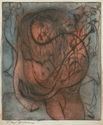
19th, 20th & 21st Century Fine Prints
707-546-7352 · fax 707-546-7924 · web: www.annexgalleries.com · email: artannex@aol.com
Norman Carton Biography
Norman Carton
American
1908–1980
Biography
Painter, printmaker, theater set designer, and muralist Norman Carton was born on January 7, 1908, in Dneiper, Ukraine, then a part of the Russian empire. Most of his childhood was spent in upheaval as his family was constantly on the move, escaping civil war. They finally immigrated to the United States in 1922, settling in Philadelphia, PA. Carton attended the Pennsylvania Museum School of Industrial Art in the late 1920s, supporting himself as an illustrator for the Philadelphia Record from 1928 to 1930. While there, he become acquainted with artists of the Ashcan school, and his interest in modern art was piqued.
From 1930 to 1935 Carton attended the Pennsylvania Academy of Arts, studying under Henry McCarter, as well as mentorships with Arthur Carles and the architect John Harbison. While there he received a Cresson traveling scholarship to Paris, where he studied the works of Matisse, Picasso, Soutine, and Kandinsky; on his return he received the Thouron Composition Prize and the Toppan Prize for figure painting. Upon graduation, he enrolled in courses at the Barnes Foundation for one year, exposing himself to the philosophical theories of lecturers John Dewey and Bertrand Russell. Carton began to associate himself with Social Realism movements, and his works for the Federal Art Project, for whom he worked from 1939 to 1942, reflected his desire for a more inclusive and just sociopolitical society. Commissioned murals included the Helen Flaischer Vocational School for Girls, Philadelphia, PA; the officer's club at Camp Meade Army Base, Maryland; and for the city of Hidalgo, Mexico. With the outbreak of World War II, he took a position as a naval structural designer and draftsman for Cramp Shipbuilding.
Following the end of the war, Carton, who had been a textile designer during the Depression, co-founded a fabric plant in Philadelphia where he designed hand-printed fabrics for major fashion houses and interior designers, including Lord & Taylor, Nina Ricci, and Gimbels. Once the company was established, he sold his portion of the partnership in order to focus on becoming a full time fine artist, marking the beginning of his second career.
Carton identified his work with the Abstract Impressionist movement, a term coined by artist Elaine de Kooning. He began exhibiting throughout the United States and abroad beginning in 1949, with a solo show that took place at the Philadelphia Art Alliance. This led to major group and solo exhibitions throughout Philadephia and New York, and he founded and was the first president of the Philadelphia chapter of the Artist's Equity Association. He taught painting to support himself for a brief time but in 1950 he was commissioned by the Philadeplphia Museum of Art and the organizatio of the National Museums of France to travel to Europe on a color photography study of major continental masterpieces. He was also one of the few artists allowed to obverve the restoration of the Mona Lisa and was given permission to help remove the painting from its frame. He remained in France until 1953, exhibiting at major salons and juried exhibitions to critial acclaim.
His return to the United States kickstarted a prolific and busy career for the artist who now had an international reputation, and was included in groundbreaking shows featuring leading American Abstract Expressionists in leading gallery and museum shows throughout the U.S. In 1962 he co-founded the Dewey Gallery, significant for being one of the first artist-operated galleries in New York City. He was recognized not only for his style and technique, but also for his dedication to being involved in the entire process, grinding pigments for his own paints and inks.
In addition to a successful fine art career, Carton was a celebrated educator, teaching and lecturing throughout the United States and abroad. He was a painting and composition teacher at the Philadelphia Museum of Art from 1948 to 1949; he conducted seminars at the Loures and Sorbonne and deisgned sets and costumes for the theater while living in Paris in the early 1950s; leactured at the Pratt Institute; the Chrysler Museum of Art; and the Whitney Museum of Art; and in 1960 he was hired onto the faculty at the New School for Social Research in New York City, where he would remain until his death of a heart attck in 1980.
Carton's work is held in the permanent collections of the Whitney Museum of American Art; the Albright-Knox Gallery; the Norfolk Museum of Art; the Chrysler Art Museum; the Jewish Museum, Parisl the Museum of Modern Art, Paris; and the Museum of Art in Denis, France, among others.

